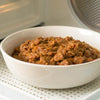How Long Can Wet Dog Food Stay Out? A Complete Guide for Pet Owners
- Houndsy
Table of Contents
- Introduction
- Understanding Wet Dog Food: Composition and Importance
- How Long Can Wet Dog Food Sit Out? The Key Facts
- Signs That Canned Dog Food Has Gone Bad
- How to Store Opened Cans of Dog Food Safely
- Practical Tips to Prevent Waste and Keep Your Dog's Food Fresh
- Managing Your Dog’s Feeding Routine for Freshness and Health
- How Houndsy Elevates Your Feeding Experience
- Conclusion
Introduction
Imagine the scene: you just filled your dog’s bowl with fresh wet food, but life got busy, and several hours later, it's still sitting out. As devoted pet parents, we understand the importance of proper nutrition, but how much do we know about food safety when it comes to wet dog food? With its rich flavors and higher moisture content making it a favorite among many four-legged friends, wet dog food requires special handling. An essential point that every pet owner should grasp is: How long can wet dog food stay out before it becomes unsafe?
In this article, we will dive into the specifics of wet dog food, explore the recommended time limits for keeping it out, and discuss how to avoid spoilage to ensure your furry friend stays healthy and happy. By addressing key questions surrounding wet dog food safety, storage practices, and ideal feeding routines, we aim to help you streamline your dog feeding experience while preventing any health issues associated with spoiled food. We encourage you to reflect on your feeding practices and consider how small adjustments can lead to significant benefits for your beloved pet.
The guidance provided here will not only underscore the fundamentals of wet dog food storage but will also be enhanced by our commitment to elevating the pet care experience through products like the Houndsy Kibble Dispenser. This device embodies our mission to enhance functionality and design, making feeding more convenient, consistent, and beautiful. Let’s dig in!
Understanding Wet Dog Food: Composition and Importance
What Is Wet Dog Food?
Wet dog food, commonly available in cans or pouches, is characterized by its significantly higher moisture content, boasting around 70% to 80% water. This type of food generally has a rich, pâté-like texture complemented by meat, vegetables, and grains. Due to its nutritional density and easier digestibility, wet food has become a popular choice among dog owners.
The Nutritional Value of Wet Dog Food
Wet dog food is formulated to provide a complete and balanced diet, adhering to standards set by the Association of American Feed Control Officials (AAFCO). This ensures that every bite contains essential nutrients, including proteins, fats, vitamins, and minerals.
- Hydration: The added moisture can help hydrate dogs, particularly those who may not drink enough water throughout the day.
- Palatability: The rich flavor and aroma entice picky eaters and younger dogs who need increased hydration for optimal health.
- Digestibility: The softer texture is easier for puppies, seniors, and dogs with dental issues.
Understanding the qualities of wet dog food is crucial for determining how to provide safe and enjoyable meals for our furry companions.
Why Moisture Matters in Food Safety
While the moisture in wet dog food is beneficial for hydration and nutritional absorption, it also creates an environment that promotes bacterial growth if left unattended. This is why understanding how long wet dog food can be left out is critical for your pet’s safety.
How Long Can Wet Dog Food Sit Out? The Key Facts
Expert Recommendations on Time Limits
Veterinary and food safety guidelines clearly state that wet dog food should not remain out for more than two hours at room temperature. If the room temperature is above 90°F (or around 32°C), this time decreases to one hour.
- Bacterial Growth: Food left out becomes a breeding ground for bacteria; in warm, humid conditions, this proliferation can happen exceedingly fast.
- Spoilage Indicators: Signs of spoilage may include off odors, slimy textures, or color changes.
- Health Risks: Feeding spoiled wet food can lead to a range of health concerns, including diarrhea, vomiting, and severity of symptoms can escalate with foodborne bacteria.
What Happens If Wet Food is Left Out Overnight?
Leaving wet dog food out overnight is a strict no. The risk of bacteria multiplying exponentially overnight can lead to severe health issues for your pet, making proper storage a non-negotiable practice.
Dry Dog Food Vs. Wet Dog Food: Key Differences in Handling
Many dog owners tend to confuse the handling of wet dog food with that of dry kibble. While dry dog food can typically sit out for up to eight hours without significant risks, wet dog food should be treated with far greater care due to its moisture levels.
Signs That Canned Dog Food Has Gone Bad
Knowing how to identify spoiled wet dog food can safeguard your pet from potential harm. Here’s what to look for:
- Foul Odors: A sour or rancid smell indicates spoilage.
- Color Changes: Unnatural darkening or discoloration can signal that the food has gone bad.
- Texture Changes: Sliminess or excessive liquid separation suggests bacterial activity.
- Visible Mold: Any mold growth signals it’s time to toss the food.
Remember, some bacteria may not produce visible signs, making it prudent to adhere strictly to advised time limits for food sitting out.
How to Store Opened Cans of Dog Food Safely
Refrigeration is key when it comes to preserving wet dog food once a can is opened.
- Transfer Unused Food: Always transfer any leftover food into an airtight container to keep it fresh.
- Keep it Cool: Refrigerate leftovers promptly, ensuring temperatures remain below 40°F (4°C).
- Consume Quickly: Aim to use leftover food within three to five days based on manufacturer recommendations.
Avoid the temptation to leave food in the opened can after serving, as oxidation can result in loss of quality and potential contamination.
Best Practices for Storing Wet Food
- Use Airtight Containers: Dedicated pet food containers with BPA-free technology are ideal.
- Avoid Fluctuating Temperatures: Don’t store food in areas where temperature and humidity can change.
- Seal Properly: If opting to keep the food in the original can, tightly seal it with a plastic lid or wrap it securely.
Practical Tips to Prevent Waste and Keep Your Dog's Food Fresh
Purchase Appropriate Can Sizes
Choose can sizes that align with your dog's appetite and typical meal portion. Smaller cans minimize leftover food and reduce spoilage risks.
Measure Portions
Over-serving can lead to more waste. Using devices like the Houndsy Kibble Dispenser, which provides precise portion control for dry food, encourages mindful feeding habits and prevents excess.
Clean Bowls Regularly
Frequent cleaning of feeding dishes prevents bacterial buildup and contamination of the fresh food you serve your pooch.
Freeze Excess Wet Food
If you have opened cans, consider freezing portions of wet dog food in airtight containers. Defrost them in the refrigerator—never at room temperature—to maintain food safety.
Managing Your Dog’s Feeding Routine for Freshness and Health
Implementing a consistent feeding schedule can enhance your pet’s well-being and reduce food waste.
Scheduled Feeding vs. Free Feeding
Many pet parents grapple with their feeding routines. Scheduled feeding—serving meals at specific times—ensures your dog eats fresh food, while free feeding can leave food sitting out and potentially becoming stale or spoiled.
Importance of Portion Control
Establishing portion control can minimize leftovers and ensure your dog receives the right amount of nutrition. Innovative solutions, such as the ergonomic and stylish Houndsy Kibble Dispenser, can elevate this experience, promoting a healthier feeding routine.
Observing Eating Habits
Changes in your dog’s eating habits may indicate health issues. Notice if they consistently leave food uneaten or express new pickiness, as these behavioral shifts warrant a discussion with your veterinarian.
How Houndsy Elevates Your Feeding Experience
At Houndsy, we're passionate about redefining pet feeding experiences. Our flagship product, the Houndsy Kibble Dispenser, encapsulates our mission to simplify and beautify daily pet care rituals.
What Makes Houndsy Different?
-
Convenience at Standing Height: We know that pet feeding can often involve awkward bending and lifting. Our ergonomic design allows for feeding comfort, removing strain from the pet parent’s routine.
-
Perfect Portion Control: Each crank dispenses consistent portions, allowing for precise feeding every time, ensuring that your furry friend gets just what they need without mess or waste.
-
Stylish and Functional Design: Our dispenser fits seamlessly into contemporary home decor, making meal times something you can display with pride.
We believe that practicality and elegance can coexist, allowing the shared ritual of feeding to be a joy rather than a chore.
Conclusion
In summary, understanding how long wet dog food can stay out is foundational to ensuring the health and happiness of our canine companions. We reviewed crucial time limits, studied the signs of spoilage, and discussed the nuances of proper storage and feeding routines.
Adhering to these practices not only safeguards our pets’ health but also enhances the quality of their feeding experience. As loving pet owners, it’s our responsibility to provide fresh, safe, and nutritious meals for our furry friends.
We invite you to reflect on your feeding habits and consider the advantages of solutions that promote convenience and quality, like the Houndsy Kibble Dispenser. Discover how our innovative designs can elevate your daily routines and transform meal times into moments of joy. Order now and explore the Houndsy Kibble Dispenser!
FAQ
1. How long can wet dog food stay out?
Wet dog food should not be left out for more than two hours at room temperature or one hour in hot conditions.
2. Are there any signs that indicate wet dog food has gone bad?
Yes, signs include foul odors, color changes, slimy textures, and visible mold.
3. How should I store opened wet dog food?
Transfer the food to an airtight container and refrigerate. Consume within three to five days, depending on the manufacturer’s guidelines.
4. Can I freeze wet dog food?
Freezing may alter texture and taste, but excess portions may be frozen for later use. However, it’s recommended to thaw in the refrigerator.
5. What are the risks of feeding spoiled wet dog food?
Spoiled food can lead to health issues, including gastrointestinal distress, vomiting, and foodborne illnesses.
By implementing these guidelines into your feeding routines, you can keep your beloved dog happy and healthy, ensuring that every mealtime is a happy one.












